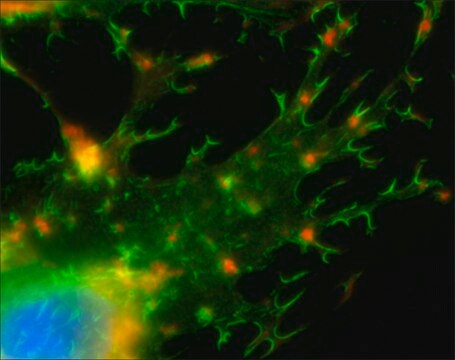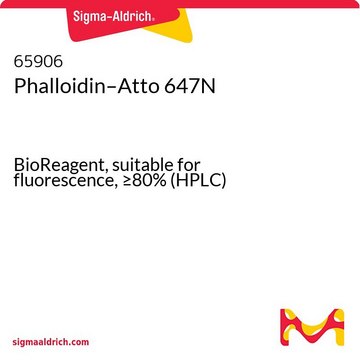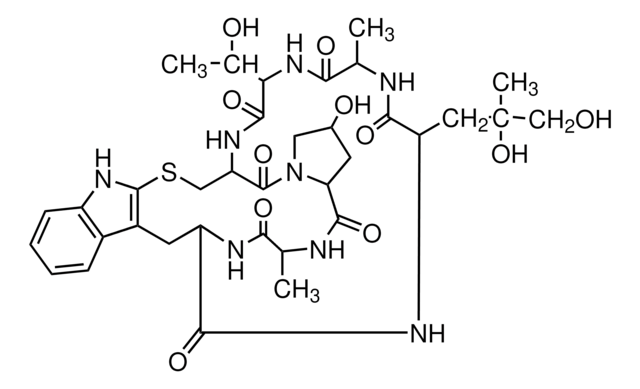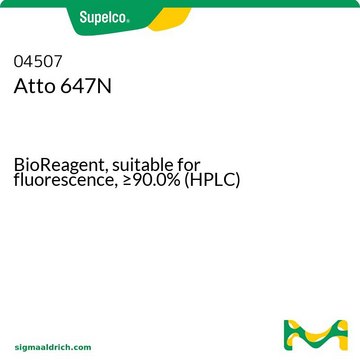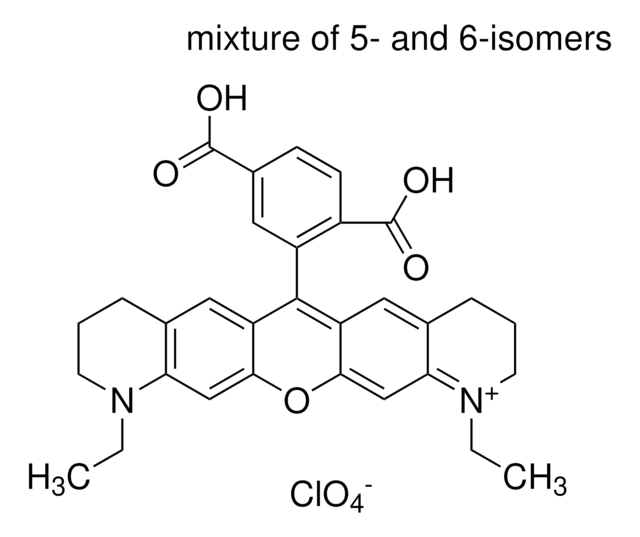94072
Phalloidin–Atto 565
suitable for fluorescence, ≥80.0% (HPLC)
Se connecterpour consulter vos tarifs contractuels et ceux de votre entreprise/organisme
About This Item
Code UNSPSC :
12352108
Nomenclature NACRES :
NA.32
Produits recommandés
Niveau de qualité
Essai
≥80.0% (HPLC)
Forme
solid
Poids mol.
Mw 1394 g/mol
Fabricant/nom de marque
ATTO-TEC GmbH
λ
in methanol
Absorption UV
λ: 562.0-568.0 nm Amax
Adéquation
suitable for fluorescence
Température de stockage
−20°C
Description générale
Atto 565 is a novel fluorescent label that belongs to the class of Rhodamine dyes. It shows a strong absorption, high fluorescence quantum yield, high thermal and photostability, and a very little triplet formation. Atto 565 consists of a mixture of two isomers with practically identical optical absorption and emission Phalloidin is a fungal toxin isolated from the poisonous mushroom Amanita phalloides. Its toxicity is attributed to the ability to bind F actin in liver and muscle cells. As a result of binding phalloidin, actin filaments become strongly stabilized. Phalloidin has been found to bind only to polymeric and oligomeric forms of actin, and not to monomeric actin. The dissociation constant of the actin-phalloidin complex has been determined to be on the order of 3 x 10-8. Phalloidin differs from amanitin in rapidity of action; at high dose levels, death of mice or rats occurs within 1 or 2 hours. Fluorescent conjugates of phalloidin are used to label actin filaments for histological applications. Some structural features of phalloidin are required for the binding to actin. However, the side chain of amino acid 7 (g-d-dihydroxyleucine) is accessible for chemical modifications without appreciable loss of affinity for actin.
find more information here
find more information here
Code de la classe de stockage
11 - Combustible Solids
Classe de danger pour l'eau (WGK)
WGK 3
Point d'éclair (°F)
Not applicable
Point d'éclair (°C)
Not applicable
Faites votre choix parmi les versions les plus récentes :
Déjà en possession de ce produit ?
Retrouvez la documentation relative aux produits que vous avez récemment achetés dans la Bibliothèque de documents.
Les clients ont également consulté
Recombinant Extracellular Matrix Protein Fragments Support Human Embryonic Stem Cell Chondrogenesis.
Aixin Cheng et al.
Tissue engineering. Part A, 24(11-12), 968-978 (2017-12-28)
We previously developed a 14-day culture protocol under potentially GMP, chemically defined conditions, to generate chondroprogenitors from human embryonic stem cells (hESCs). In vivo work has confirmed the cartilage repair capacity of these cells in a nude rat osteochondral defect
Silke Rothenbusch-Fender et al.
Biology open, 6(12), 1876-1888 (2017-11-11)
During
A Béduer et al.
Acta biomaterialia, 76, 71-79 (2018-06-09)
We present a 3D-printing technology allowing free-form fabrication of centimetre-scale injectable structures for minimally invasive delivery. They result from the combination of 3D printing onto a cryogenic substrate and optimisation of carboxymethylcellulose-based cryogel inks. The resulting highly porous and elastic
PALM and STORM. Unlocking live-cell super-resolution.
Henriques, R.; Griffiths, C.; Hesper Rego, E.; Mhlanga, Musa M.
Biopolymers, 95(5), 322-331 (2011)
Direct stochastic optical reconstruction microscopy with standard fluorescent probes.
van de Linde, S.; et al.
Nature Protocols, 6(7), 991-1009 (2011)
Notre équipe de scientifiques dispose d'une expérience dans tous les secteurs de la recherche, notamment en sciences de la vie, science des matériaux, synthèse chimique, chromatographie, analyse et dans de nombreux autres domaines..
Contacter notre Service technique